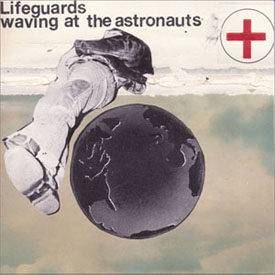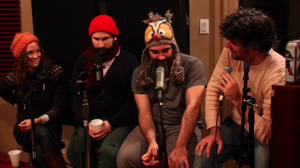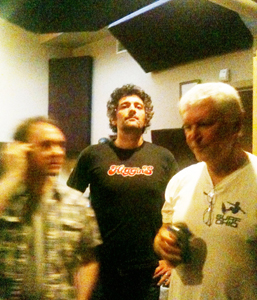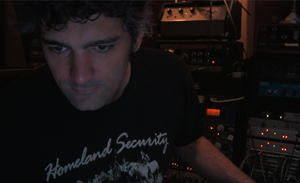Dream Gig: Travis Harrison Records Guided By Voices Heroes at Serious Business
SoHo, Manhattan: Travis Harrison — record producer, engineer, founder of Serious Business Records & Studio and Guided By Voices super-fan — met late era GBV guitarist Doug Gillard when his band, The Unsacred Hearts, shared a bill with Gillard at Piano’s.
Harrison gushed about GBV, Gillard dug The Unsacred Hearts, and they stayed in touch. Later on, Harrison inquired about future prospects for Lifeguards, the Gillard and Robert Pollard GBV side-project whose one and only release, Mist King Urth, came out in ’02.
“I was a huge fan of the first Lifeguards album,” says Harrison, “I buy everything that Bob [Pollard] puts out. After I met Doug, Bob had been in touch to tell him if he wanted to produce the music and find a label, he’d be into doing another Lifeguards record. That’s when I swooped in and pitched Doug: I have a studio, a label, the [recording] skill-set and I’m a huge fan. Let’s do this! I expected to get no response.”
Of course, Gillard did respond and the new Lifeguards record, due out February 15 on Serious Business / Ernest Jenning Record Co., was engineered by none other than Harrison. Scroll down to stream “Product Head,” the album’s single released on 7″ in advance of the record. And read on for an interview about the recording and production of Lifeguard’s Waving At The Astronauts by this Guided By Voices super-fan…
Awesome that you got to engineer this record at Serious Business! So tell me about how it all came together.
The way they worked on this project is that Doug wrote the instrumentals and recorded them at home in Garage Band and then sent them to Bob who then created the melodies and lyrics on top of these instrumentals. It’s just one of the many ways that Bob works.
Doug’s GarageBand demos were pretty fully fleshed out — he recorded most of the guitars, and bass and other little sonic treatments. Then he brought it to me and at my studio, I salvaged any less than ideally recorded stuff, but we also tracked drums, bass, re-tracked any guitar that I could get him to re-track and then we recorded Bob’s vocals.
What were your first impressions of the material? Were you so psyched?!
First of all, I was just in awe. As far as Doug’s instrumentals go, the shit’s amazing. He’s a great guitar player, and has an amazing musical mind that always goes somewhere you don’t expect. He’s awesome. But I didn’t actually hear these tracks as songs beyond instrumentals until Bob was actually in the studio, at the microphone. He drove in from Dayton in May to do his vocals. And that was just amazing. The guy is a genius! Obviously I’m a huge fan, but just to see him work and see how completely natural and instinctual it is, I was blown away.
Wow, very cool! And I know you’re a drummer — did you by any chance get to play on the record?
Yes, I played on five songs and Doug played on the rest. He’s a great drummer, he basically plays everything, but it was obviously a crazy honor for me to play drums on this record. There were some parts that were really fast, that either exceeded his technical ability or that he thought I’d have a good groove for – that’s the stuff I got a shot at.
And what was your goal in the studio – what aspects were you re-recording or adding, and how did you approach the recording?
It was very important to me to make it sound as un-GarageBand-y as possible. We didn’t want it to sound homemade at all. And Bob’s vision for the record was like “ARENA ROCK.” He’s known for lo-fi, but we were consciously not going for that. Doug was the producer, so he really called all the shots. He called for a lot of really heavy compression on drums.
On one song in particular, “Nobody’s Milk,” Doug had done the original drum track on a drum machine and it was incredible but it wasn’t totally in time and he’d used the GarageBand compressor at 10 to really squash it. It was really clean but insanely compressed and I begged to redo them.
It took a ton of work to match his exact part because it was very intricate, but to achieve the compression, I used the API 2500 bus compressor as the first stage and then after that, the Fatso pretty much demolishing it in parallel. And I really favored the compressed side and went for this ultra squashed sound to simulate his Garage Band demo. That was my goal throughout the whole project, to please Doug and Bob as much as I could. I willingly and gladly checked my ego at the door!
In that process, do you feel like you learned from them? From following their instincts?
Of course, although this way of working — taking a fully fleshed out Garage Band demo and turning that into the record — is incredibly tedious. So it was a matter of enjoying the tedium of that. I spent an insane amount of time on my own editing, beat-by-beat, that ultra compressed drum track because I didn’t want Doug to hear really anything different from his version. I just wanted it to be real drums instead of these samples.
But do you feel you came up with something new and different in the process — something cool you wouldn’t have come up with otherwise?
Yes, but you know Doug was the producer and this is what he wanted to hear. And when he heard it, he (and Bob) loved it. But the way these guys work…and I should separate them, because Doug is more of a meticulous craftsman. But at the same time, he does kind of bang it out. He’s not going to do 30 takes of something. Where Bob does ONE take.
Tell me about that! What was it like recording Bob’s vocals on this?
I had a [Shure] SM7 set up in the studio. The SM7 is my favorite mic, especially for a singer like Bob. I was really excited. My thinking was to record Bob onto two tracks simultaneously. One track was just about capturing him with very little compression — an SM7 to a Great River mic pre to a distressor at 2:1 (but barely touching it) — and then on the other track, I hit him with an 1176 at 4:1 with the super-spitty setting (the fastest release and the slowest attack). And that’s the track I ended up using for most of the final mixes.
Also, for every track, I printed either Space Echo or Echoplex live. Bob would step up to the mic and say “Alright man, this one is arena rock!” or “This one’s Elvis!” or “psychedelic” and between the Echoplex and the Space Echo, I was able to get what I wanted. I would print that live so there were certain freak-outs in sections — wild, completely tasteless effects stuff.
Bob basically sang the record in sequence. He stepped up and sang the first song all the way through, he listened to it played back over headphones and then moved on. Couple tunes, he’d punch in a word here and there. He did Side A, then we took a break, had a couple tall, cold ones, and then move onto Side B. It was incredible. I’d always heard he was first-take-jake, and he really was. And he was in wonderful voice too. As good as I’ve ever heard him sound.
Stream “Product Head” off Lifeguards’ upcoming album Waving At The Astronauts, also now available as a single on 7″ vinyl:
LIFEGUARDS – Product Head by seriousbusiness
Awesome. And he was digging what he was hearing?
Yeah, I was giving him Space Echo on his headphones. Monitoring off my Soundcraft Ghost, I was recording the output of the Space Echo back into Pro Tools, and I knew he wanted to hear a lot of it, so I gave it to him and made it long, made it do stuff! I tried to provide him with something he was really feeling.
And that was the vocal chain throughout?
Yeah, this was a bang-it-out situation. He did the whole 10-song record in four hours, and two of the hours we were just screwing around. The thing about Bob is he doesn’t like to spend a lot of time in the studio, but he works really hard. He wakes up every morning and writes. He’d worked hard on these tunes and had practiced them a lot at home. He was on point.
And you mixed the record as well? What was the focus there?

Lifeguards' "Waving At The Astronauts" will be released on February 15 via Serious Business / Ernest Jenning Record Co.
Yes, Doug and I mixed the record together. And he’s into hearing stuff pretty bright. He doesn’t want to hear a ton of kick drum. He has a specific way that he hears records, coming from this late 70s, post-punk place, and the end result is awesome.
We worked very quickly. I mix in Pro Tools, but not in the box. I spread it out on the Ghost as much as I can and try to use as much outboard as I can, but I also keep it as recallable as possible. So I would sit at the desk and get the mix up for a few hours and then when it came time to mixdown, Doug sat at the desk and I would hit record, and he would do all kinds of cool shit!
He ended up using the console in very obviously un-Pro Tools-like ways. Like, panning sweeps on Bob’s lead vocal and on the guitar solos. Expressive moves that you wouldn’t do in Pro Tools.
And I really encouraged Doug to do this because there’s a character to all that GBV music that’s the exact opposite of Pro Tools. In the back of my mind through the whole project, I kept in mind the essential character of the GBV recordings that people love so much, and they’re on 4 track or on ADAT made in a garage somewhere.
How would you describe that “un-Pro Tools” quality? Just totally unpolished and lo-fi, or what?
Well the entire GBV and Robert Pollard’s solo oeuvre is about as varied as you can imagine. He’s obviously famous for being the king of lo-fi. You have certain records, like Vampire On Titus, which just sounds like the shittiest possible thing you can imagine. 4-track and whoa…you can barely hear the vocals! It takes like 8 listens to realize how amazing the songs are.
On the other hand, they made records with Ric Ocasek and Rob Schnapf for TVT, and those are glossy and way more hi-fi. The Rob Schnapf record sounds incredible. It’s a huge guitar record, lots of compression but modern sounding. So they run the gamut.
But the quality I’m talking about is… this thing we all get into when we make records with Pro Tools — even when you’re not trying to make polished sounding music, you polish your mixes because you can do anything you want. You have all these shades of subtlety…all these things you can do in Pro Tools, where when you’re working with this big beast of a board and you’re just trying to get something done, you make mistakes and the mistakes becomes the essential character of the music.
Do you feel you had to hold yourself back from the way you usually engineer records at all to capture that?
Yes, somewhat. But in this case, a lot of times there just wasn’t any time to do things that I should have done. Like getting the drum mics perfectly in phase, or creating musically perfect EQ relationships between all the overdubs — all the things we do as mix engineers. We just did it fast. And that speed is an essential part of the GBV aesthetic. Bob does not ponder the music.
Awesome, well congrats! Now, fill us in on Serious Business — it’s a studio and a record label — how long have you been around?
I started the Serious Business studio in Long Island City with my good buddy, Andy Ross, who’s now the guitar player in OK Go. We had a G4 with Pro Tools and the audacity to put an ad on Craigslist advertising as a studio, and that’s what I’ve been doing ever since.
We moved from there to a big loft in Williamsburg and then partnered up in a collective-type fashion — an engineer friend of mine, Halsey Quemere, brought a tape machine (a Sony MCI, acquired from Jimmy Douglass) into the fold, and then I felt we needed a more proper studio space, so we found the SoHo location. Last year, I hooked up with [producer/engineer] Shannon Ferguson (of Longwave, etc.) and with him came this great influx of cool gear.
And the label? You guys are actually putting out the Lifeguards release, yes?
Yes, I started the label awhile back as an outlet for my own bands, and my friends’ bands, and though it tends to take a back seat to other (paying) gigs, it’s continued as a total labor of love. Artists like Benji Cossa, Higgins, Rocketship Park, etc. it is all music I love. The binding theme of the label is Class A songwriting.
For Lifeguards’ Waving At The Astronauts, Serious Business is partnering with Ernest Jenning to put it out. I did the A&R and recording and production and layout of the artwork, and Ernest Jenning is doing the promotion and distribution, etc.
And you’re also doing a podcast for BreakThru Radio — it’s cool! Tell us about that!

In this week's "Serious Business Live on BreakThru Radio," Travis Harrison (at right) welcomes Dawn Landes and band into the studio.
BreakThru Radio produces a ton of original content — including a few in-studio sessions with bands. The main property is a show called “Live Studio,” where the band comes in, plays a set, and talks to the host Maya MacDonald, a college radio-style interview. I started recording the lion’s share of those last year at Serious Business, and after awhile, I convinced them to give me my own show!
My show is the same kind of format, but way less formal — there’s drinking, silly craziness and lots of potty-mouth. My vision for that show is to create an atmosphere of what it’s really like when bands come into the studio to record with me. So far I haven’t gotten fired, which is a miracle!
Tune in every Monday morning for a new installment of Serious Business Music Live on BreakThru Radio Check out Serious Business, the studio, at http://www.seriousbusinessmusic.com and the label, at http://www.seriousbusinessrecords.com. And pick up the Lifeguards single “Product Head on iTunes.








